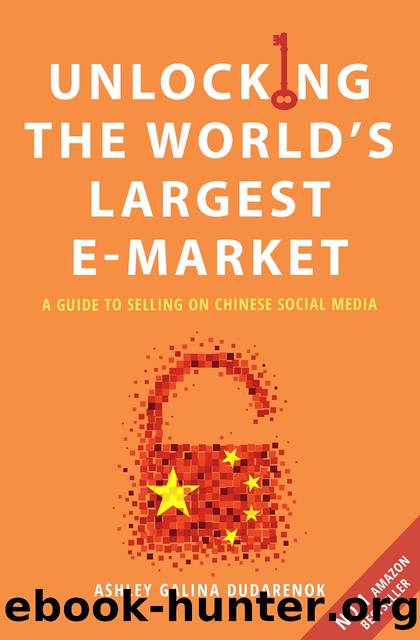Unlocking the World's Largest E-Market by Ashley Galina Dudarenok

Author:Ashley Galina Dudarenok
Language: eng
Format: epub
Publisher: Alarice International
“From what we can see today the future of WeChat in the next 2 years will be in large part based around improving search and improving mini programs. For WeChat mini programs, it’s no exaggeration to say that they are the future of WeChat. The only question is how much will they go on to impact the rest of the mobile ecosystem in China.”
—Matthew Brennan, Co-founder of China Channel
Part II is about WeChat, its diverse functions and how Chinese consumers are living with it. It’s becoming the operating system for most Chinese users and continues to add more and more diverse functions.
There’s a common misconception that every brand that has entered China must have their own official WeChat account. However, this is not entirely so. For example, WeChat is not really for B2B brands. Their target audience is really niche due to their professional expertise and is less interesting for general users.
Another false assumption is that a brand can rely on WeChat alone and expect a presence there to bring them everything they want. As a semi-closed platform, WeChat maintains a relatively intimate relationship between users and also between users and brands. This means that initially, it’s not the ideal platform to gain popularity and grow followers. A more reasonable approach is to leverage WeChat after you’ve accumulated a stable audience on other platforms, and then drive them to WeChat for further relationship development.
In Part I, three categories of brands were discussed based on their China market entry mode. They were international brands already in China, brands doing cross-border e-commerce and overseas brands serving Chinese visitors. In this chapter, we’ll see how these three types of brands should use WeChat and the most relevant tools or functions for each type of brand.
1. International Brands Already in China
These brands have already set up a legal entity in China. They have online stores, brick-and-mortar stores or both in mainland China. They employ local staff and are well-adapted to the local e-commerce ecosystem. These brands are already known to some Chinese consumers.
Official Account and WeChat Articles
It’s good for these brands to have their own official WeChat account. However, as mentioned above, WeChat is not for everyone. Before making the decision, brands should think about who their target audience is and whether they can leverage WeChat’s functions for maximum effect.
Regular posting is essential to keep the audience updated. Articles are the most popular content type on WeChat. Most subscription accounts post one to three articles once a day while service accounts usually post four to five articles once a week.
These articles are also important for interactive campaigns. Brands can encourage users to leave a comment under an article for lucky draws, or ask them to share an article to Moments to accumulate enough “likes” to receive special offers, which helps them get more exposure.
Custom Menu Bar for CRM
WeChat is an ideal tool for customer relationship management. A great variety of third-party CRM tools can be integrated within WeChat as well. Brands can make full
Download
This site does not store any files on its server. We only index and link to content provided by other sites. Please contact the content providers to delete copyright contents if any and email us, we'll remove relevant links or contents immediately.
| Advertising | Consumer Behavior |
| Customer Service | Marketing |
| Public Relations | Sales & Selling |
| Search Engine Optimization |
Influence: The Psychology of Persuasion by Robert B. Cialdini(4179)
The Miracle Morning by Hal Elrod(3910)
The Hacking of the American Mind by Robert H. Lustig(3580)
Pre-Suasion: A Revolutionary Way to Influence and Persuade by Robert Cialdini(3414)
Unlabel: Selling You Without Selling Out by Marc Ecko(2981)
Hidden Persuasion: 33 psychological influence techniques in advertising by Marc Andrews & Matthijs van Leeuwen & Rick van Baaren(2778)
Who Can You Trust? by Rachel Botsman(2732)
Kick Ass in College: Highest Rated "How to Study in College" Book | 77 Ninja Study Skills Tips and Career Strategies | Motivational for College Students: A Guerrilla Guide to College Success by Fox Gunnar(2720)
Purple Cow by Seth Godin(2698)
Ogilvy on Advertising by David Ogilvy(2682)
I Live in the Future & Here's How It Works by Nick Bilton(2524)
This Is Marketing by Seth Godin(2482)
The Marketing Plan Handbook: Develop Big-Picture Marketing Plans for Pennies on the Dollar by Robert W. Bly(2414)
The Power of Broke by Daymond John(2376)
Building a StoryBrand by Donald Miller(2360)
The 46 Rules of Genius: An Innovator's Guide to Creativity (Voices That Matter) by Marty Neumeier(2310)
Draw to Win: A Crash Course on How to Lead, Sell, and Innovate With Your Visual Mind by Dan Roam(2277)
The Tipping Point by Malcolm Gladwell(2204)
Market Wizards by Jack D. Schwager(2163)
